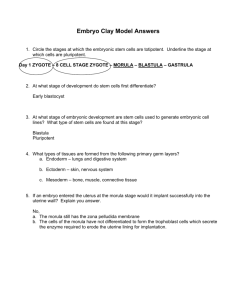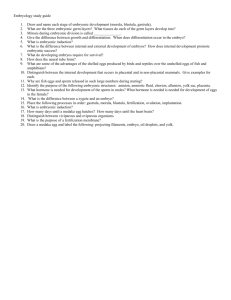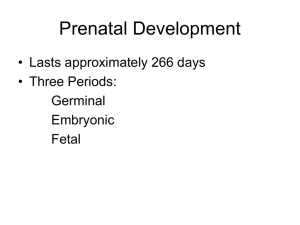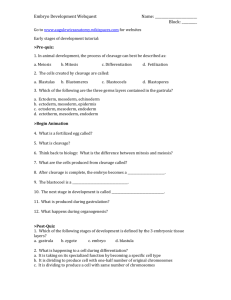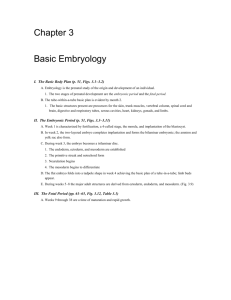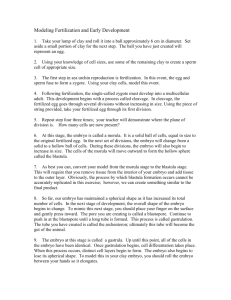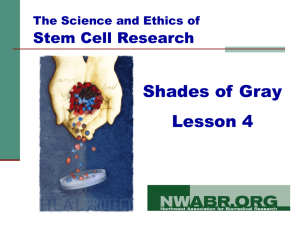DEVELOPMENT
advertisement
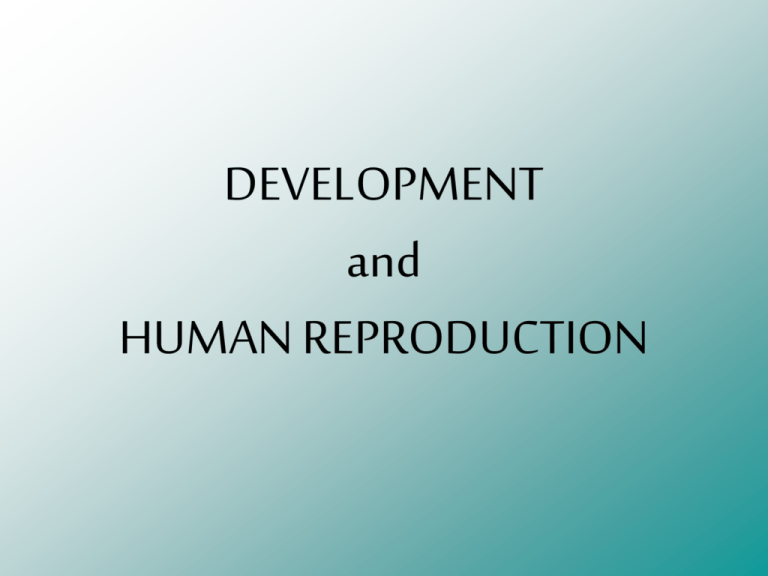
DEVELOPMENT and HUMAN REPRODUCTION VOCABULARY 1. EMBRYOLOGY: the study of the development of embryos 2. CLEAVAGE: series of cell divisions of the zygote that occurs without growth until cells are reduced to adult size 3. GASTRULATION: when cells of the blastula cave in to form the gastrula 4. DIFFERENTIATION: transformation of unspecialized cells into specialized cells, tissues, and organs 5. ZYGOTE: the diploid cell resulting from fertilization of the egg by sperm 6. EMBRYO: multicellular organism in the early stages of development 7. BLASTULA: early stages of embryonic development when a single layer of cells have a fluid filled center 8. GASTRULA: early stage of embryonic development when primary germ layers are forming 9. MORULA: early stage of embryonic development when a solid ball of cells are formed by cleavage of the fertilized egg 10. PLACENTA: a temporary organ through which the fetus is provided food and oxygen from the mother and gets rid of wastes for the fetus 11. UMBILICAL CORD: the structure that connects the fetus to the placenta 12. PRENATAL: before birth 13. POSTNATAL: after birth 14. GESTATION: the length of the pregnancy 15. AMNIOTIC SAC: fluid filled sac that surrounds and protects the embryo 16. AMNIOTIC FLUID: fluid that fills the amnion THE EMBRYO’S EARLY STAGES OF DEVELOPMENT CLEAVAGE ♦ Early mitotic divisions of the zygote ♦ Increase in cell numbers, decrease in cell size ♦ Solid ball of cells = morula ♦ Cells then arrange into a hollow sphere = blastula ♦ Hollow center = blastoceal Identify the diagrams ZYGOTE MORULA BLASTULA GASTRULATION (occurs in about 3 weeks) ♦ ♦ ♦ ♦ cells start to grow before dividing cells on one side move inward inner layers form = primary germ layers three layered embryo = gastrula 1. ECTODERM • • • 2. • • • • 3. nervous system, brain lining of mouth, nose, anus outer layer of skin, nails, hair MESODERM GASTRULA (three layered embryo) ENDODERM bones and muscles blood and blood vessels reproductive and excretion cells inner layer of skin ENDODERM • • • • lining of digestive tract lining of respiratory tract liver, pancreas endocrine glands and bladder ECTODERM MESODERM DIFFERENTIATION ♦ a series of changes in the embryonic cells resulting in unspecialized cells → specialized cells → tissues → organs ♦ all cells have the same DNA ♦ different sections of the cells’ DNA may be “turned off” or “turned on” causing differentiation into specific kinds of cells GROWTH ♦ increase in cell size as well as the number of cells resulting in GASTRULA EMBRYO FETUS BABY CHILD TEEN ADULT STAGES OF EMBRYONIC DEVELOPMENT fertilized egg 2 cells blastula 4 cells gastrulation 8 cells gastrula stage morula WHAT an EMBRYO NEEDS 1. 2. 3. 4. 5. food (yolk) temperature control oxygen waste removal protection WHERE DOES DEVELOPMENT TAKE PLACE? 1. EXTERNAL DEVELOPMENT or 2. INTERNAL DEVELOPMENT EXTERNAL DEVELOPMENT development of the embryo outside of the mother’s body (in water or on land) 1. External development in water: • • • • food = yolk oxygen and wastes diffuse in and out temperature = mating occurs at the right time of year large numbers of eggs – so many get eaten EXTERNAL DEVELOPMENT development of the embryo outside of the mother’s body (in water or on land) 1. External development on land: • • • • food = yolk oxygen and wastes diffuse in and out watery environment inside the shell eggs are protective or mom protects (birds) INTERNAL DEVELOPMENT development of the embryo inside of the mother’s body 1. Eggs – sharks, garter snakes (food provided by yolks) 2. Embryos develop in womb or uterus • • born undeveloped – feed on mother’s milk well protected by mom (most survive) INTERNAL DEVELOPMENT development of the embryo inside of the mother’s body ♦ Placenta mammals – blood circulation of the embryo in close contact with mom’s through the placenta ♦ Non-placenta mammals 1.egg-laying mammals (anteater, duckbill platypus) 2.pouched mammals development completes in pouch (marsupials/kangaroos) 2. amniotic fluid 3. allantois 1. chorion 4. embryo 5. air space 9. shell 6. yolk sac 8. albumin 7. yolk Give the function of the following: Extraembryonic membranes: 1. Chorion ♦ Gas exchange between the embryo and the environment 2. Allantois ♦ ♦ ♦ Extension of the embryo’s digestive tract Its blood vessels exchange gases Collects metabolic waste 3. Amnion ♦ Cushion for protection 4. Yolk sac ♦ Food source
